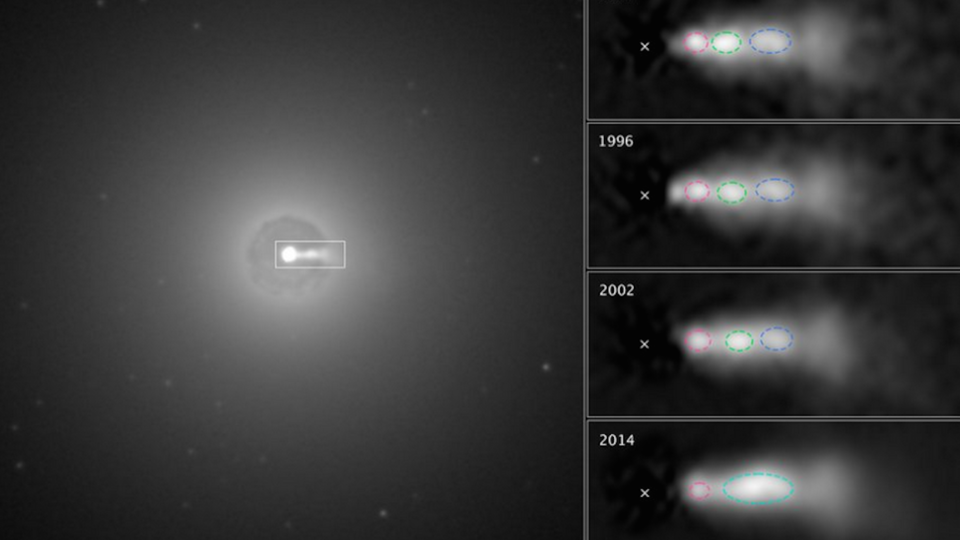Science News
Astromice, a Kuiper Belt Twin, and a Collision

Mice in Space
The human body faces many challenges in space, but so does the rodent body, according to a new study. In 2009, three “lucky” mice took a journey into space aboard the Space Shuttle Discovery heading to the International Space Station. After a few months, they headed back for Earth, and the lab, so scientists could understand the effects of life off our planet.
In all, the astromice spent 91 days in weightlessness—the longest duration of any non-human animal in space. Less lucky mice spent the same time on the ground in similar conditions as a control group. Upon the astromice’s return, Betty Nusgens, of the University of Liège, and her colleagues investigated the impact of prolonged exposure to extreme space conditions on mouse skin physiology.
Compared to mice on the ground, alterations affecting the dermal, hair follicles, and muscular compartments of the skin were observed in the astromice. Hair follicles were in the active growth phase while they should have been in the rest phase. Skin thinning was also noted in the astromice.
These alterations in the skin of mice suggest that human astronaut skin may also experience detrimental changes during long trips in space. In fact, astronauts have previously described skin dryness and itching after spending time in space, making the skin more susceptible to scratches and irritation.
A special space skin lotion may be needed for further space adventures. (And that’s not all according to this recent article in Popular Science.) –Molly Michelson
Early Solar System Analog Snapshot
One benefit, if not the primary one, of studying exoplanet systems is that we can compare them to our solar system to gain a better understanding of its history and maybe even its future.
In an article published this week in Astrophysical Journal Letters, astronomers describe a disc of planetary debris surrounding a young star only slightly more massive than our sun that shares remarkable similarities with the Kuiper Belt, the icy area are of our solar system beyond Neptune.
"It's almost like looking at the outer Solar System when it was a toddler," says Thayne Currie, of the Subaru Observatory in Hawaii.
Using the Gemini Planet Imager (GPI) at the Gemini South Telescope in Chile, Currie’s team took a closer look at the star HD 115600, 360 light years away in the Centaurus constellation and part of a massive 10-20 million year-old region called Scorpius-Centaurus OB, which is similar to the region in which the Sun was formed. HD 115600’s disk is about the same distance from the region as the Kuiper Belt is from our sun—about three and a half to five billion miles (37 and 55 Astronomical Units). The disc itself is also not perfectly centered on the star. Using models of how planets shape a debris disc, the team found that giant planets with eccentric orbits in the outer part of the system could explain the observed properties of the ring. Basically, the disc may have been sculpted by at least one, so far unseen, planet.
"To be able to directly image planetary birth environments around other stars at orbital distances comparable to the Solar System is a major advancement," says co-author Nikku Madhusudhan of the University of Cambridge. “Our discovery of a near-twin of the Kuiper Belt provides direct evidence that the planetary birth environment of the solar system may not be uncommon.” – Elise Ricard
Rear-end Collision Captured
Astronomers have discovered the first rear-end collision between two high-speed knots of ejected matter from a supermassive black hole.
Such extragalactic jets are not well understood and appear to transport energetic plasma in a confined beam from the active nucleus of the host galaxy. In this case, the jet is from the sixth brightest galaxy NGC 3862 and has a string-of-pearls structure of glowing knots of material.
Taking advantage of Hubble’s sharp resolution and long-term optical stability, Eileen Meyer of the Space Telescope Science Institute (STScI) matched archival Hubble images with a new, deep image taken in 2014 to better understand the jet’s motions. She was surprised to see a fast knot catch up with the end of a slower moving, but still superluminal, knot along the string. The resulting collision caused the merging blobs to brighten significantly.
“Something like this has never been seen before in an extragalactic jet,” Meyer says. As the knots continue merging they will brighten further in the coming decades. “This will allow us a very rare opportunity to see how the kinetic energy of the collision is dissipated into radiation,” Meyer adds. –Molly Michelson
Image: NASA, ESA, and E. Meyer (STScI)